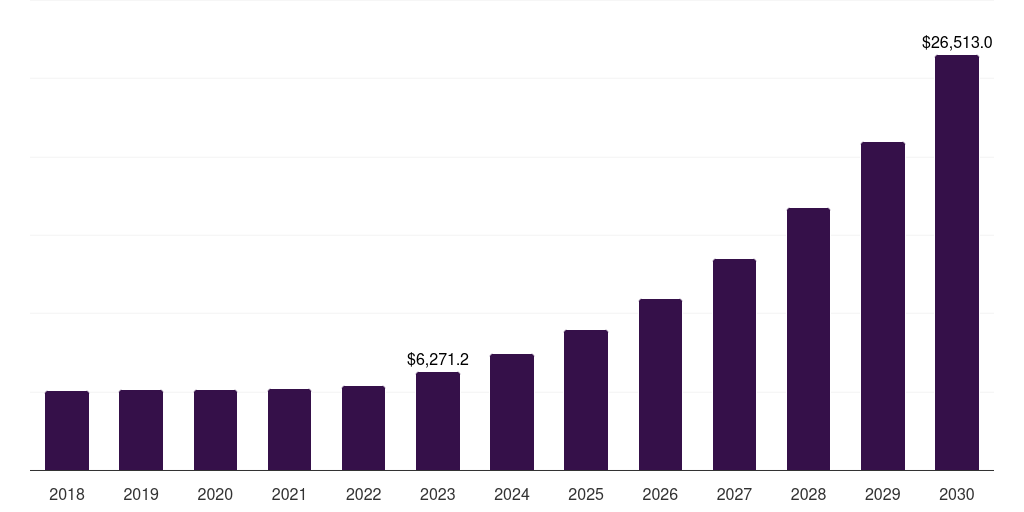Canada Plastic Resin Market Size & Outlook, 2023-2030
Canada plastic resin market, 2018-2030 (US$M)

Related Markets
Canada plastic resin market highlights
- The Canada plastic resin market generated a revenue of USD 6,271.3 million in 2023 and is expected to reach USD 26,513.0 million by 2030.
- The Canada market is expected to grow at a CAGR of 22.9% from 2024 to 2030.
- In terms of segment, polyurethane foam was the largest revenue generating type in 2023.
- Polyolefin Foam is the most lucrative type segment registering the fastest growth during the forecast period.
Plastic resin market data book summary
| Market revenue in 2023 | USD 6,271.3 million |
| Market revenue in 2030 | USD 26,513.0 million |
| Growth rate | 22.9% (CAGR from 2023 to 2030) |
| Largest segment | Polyurethane foam |
| Fastest growing segment | Polyolefin Foam |
| Historical data | 2018 - 2022 |
| Base year | 2023 |
| Forecast period | 2024 - 2030 |
| Quantitative units | Revenue in USD million |
| Market segmentation | Polyurethane Foam, Polystyrene Foam, PVC Foam, Phenolic Foam, Polyolefin Foam, Melamine Foam, Other Types |
| Key market players worldwide | Basf SE, SABIC, Dow Inc, DuPont de Nemours Inc, Evonik Industries AG, Sumitomo Chemical Co Ltd, Celanese Corp Class A, Eastman Chemical Co, Chevron Corp, Lotte Chemical, Exxon Mobil Corp, Formosa Plastics Group, Toray Industries Inc, Mitsui Chemicals Inc, Teijin Ltd, LG Chem, Avient Corp |
Other key industry trends
- In terms of revenue, Canada accounted for 4.6% of the global plastic resin market in 2023.
- Country-wise, China is expected to lead the global market in terms of revenue in 2030.
- In North America, U.S. plastic resin market is projected to lead the regional market in terms of revenue in 2030.
- Mexico is the fastest growing regional market in North America and is projected to reach USD 18,426.7 million by 2030.
No credit card required*
Horizon in a snapshot
- 30K+ Global Market Reports
- 120K+ Country Reports
- 1.2M+ Market Statistics
- 200K+ Company Profiles
- Industry insights and more
Plastic Resin Market Scope
Plastic Resin Market Companies
| Name | Profile | # Employees | HQ | Website |
|---|
Canada plastic resin market outlook
The databook is designed to serve as a comprehensive guide to navigating this sector. The databook focuses on market statistics denoted in the form of revenue and y-o-y growth and CAGR across the globe and regions. A detailed competitive and opportunity analyses related to plastic resin market will help companies and investors design strategic landscapes.
Polyurethane foam was the largest segment with a revenue share of 34.37% in 2023. Horizon Databook has segmented the Canada plastic resin market based on polyurethane foam, polystyrene foam, pvc foam, phenolic foam, polyolefin foam, melamine foam, other types covering the revenue growth of each sub-segment from 2018 to 2030.
Canada is the fourth-largest producer of crude oil globally, as of 2020. Plastic resins are produced from various petrochemicals derived from crude oil. They provide strength and durability, and are light in weight, hence plastic resins are being widely consumed across Canada.
Many new plastic manufacturers are emerging in Canada’s remote locations due to the country’s highly dispersed population. According to International Energy Agency (IEA), the per capita consumption of plastic in the country is higher than the world’s average as of 2020.
However, Tier II and Tier III cities have small population sizes leading to the need for one or two manufacturing facilities in each city. Most of the Tier I cities have established manufacturing plants leaving limited scope for the expansion of existing facilities, with almost no room for the establishment of new plants.
Reasons to subscribe to Canada plastic resin market databook:
-
Access to comprehensive data: Horizon Databook provides over 1 million market statistics and 20,000+ reports, offering extensive coverage across various industries and regions.
-
Informed decision making: Subscribers gain insights into market trends, customer preferences, and competitor strategies, empowering informed business decisions.
-
Cost-Effective solution: It's recognized as the world's most cost-effective market research database, offering high ROI through its vast repository of data and reports.
-
Customizable reports: Tailored reports and analytics allow companies to drill down into specific markets, demographics, or product segments, adapting to unique business needs.
-
Strategic advantage: By staying updated with the latest market intelligence, companies can stay ahead of competitors, anticipate industry shifts, and capitalize on emerging opportunities.
Target buyers of Canada plastic resin market databook
-
Our clientele includes a mix of plastic resin market companies, investment firms, advisory firms & academic institutions.
-
30% of our revenue is generated working with investment firms and helping them identify viable opportunity areas.
-
Approximately 65% of our revenue is generated working with competitive intelligence & market intelligence teams of market participants (manufacturers, service providers, etc.).
-
The rest of the revenue is generated working with academic and research not-for-profit institutes. We do our bit of pro-bono by working with these institutions at subsidized rates.
Horizon Databook provides a detailed overview of country-level data and insights on the Canada plastic resin market , including forecasts for subscribers. This country databook contains high-level insights into Canada plastic resin market from 2018 to 2030, including revenue numbers, major trends, and company profiles.
Partial client list
Canada plastic resin market size, by type, 2018-2030 (US$M)
Canada Plastic Resin Market Outlook Share, 2023 & 2030 (US$M)
Related regional statistics
Sign up - it's easy, and free!
Sign up and get instant basic access to databook, upgrade
when ready, or enjoy our
free plan indefinitely.
Included in Horizon account
- 30K+ Global Market Reports
- 120K+ Country Reports
- 1.2M+ Market Statistics
- 200K+ Company Profiles
- Industry insights and more



